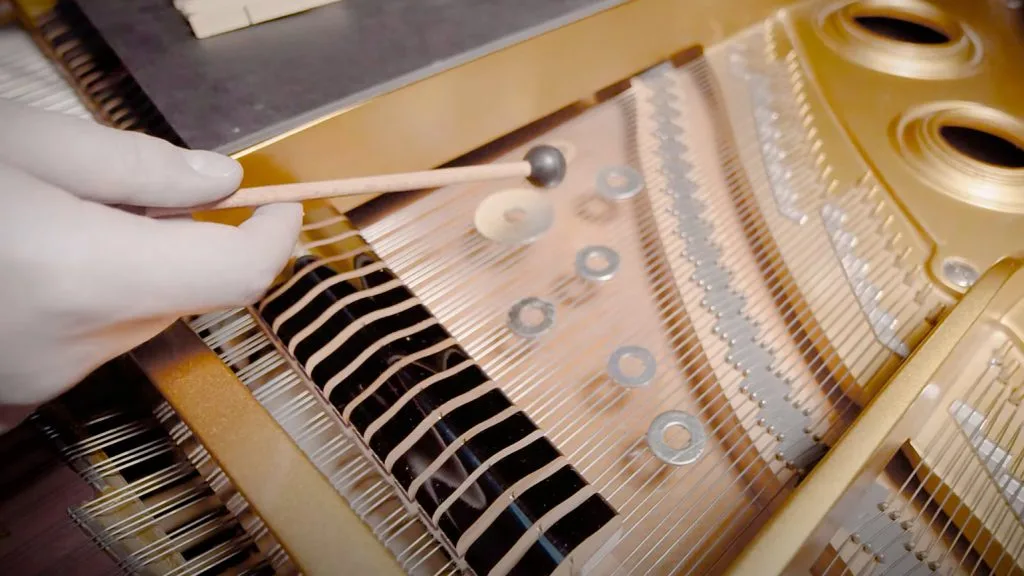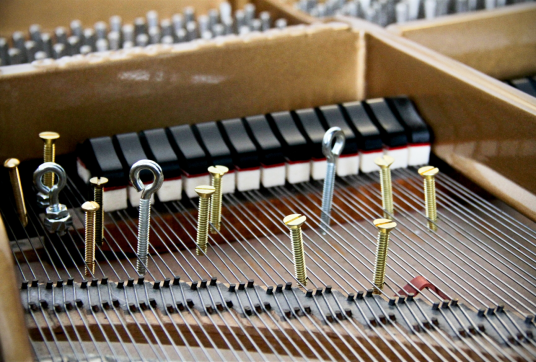Have you ever heard of a prepared piano? You may have seen one in a music video or heard its unique sound in a song, but do you really know what it is? If you’re curious and fascinated by experimental music, then this article is for you. We’ll dive into the world of prepared pianos and uncover the history behind this unconventional instrument. From its creation to its use in modern music, we’ll cover all the key details that will leave you with a deeper understanding and appreciation for this intriguing piece of musical equipment.
So let’s get started! By the end of this article, not only will you know what a prepared piano is, but also how it works, why musicians use it, and where you can hear it being played. Get ready to explore the boundaries of traditional music and delve into a whole new realm of sonic experimentation with me as your guide. Don’t worry if you’ve never played an instrument before or if your knowledge about pianos is limited – I’m here to make sure everyone can enjoy learning about this fascinating topic! So let’s press on together and discover the unique sound of the prepared piano.
So, what is a prepared piano?
A prepared piano is a traditional acoustic piano that has been modified by placing various objects, such as screws, bolts, or rubber bands, on or between the strings. This alters the sound and creates new timbres and textures that are not achievable with a regular piano. The concept was first introduced in the early 20th century by avant-garde composer John Cage who wanted to push the boundaries of traditional music and explore new sonic possibilities.
The objects placed on the strings can be anything from everyday household items to more unconventional materials like paper clips or pieces of wood. Each object produces its own unique sound when struck by the hammers inside the piano. By strategically placing these objects at different points along the strings, composers and performers can create an array of sounds ranging from percussive clicks to eerie drones.
The idea behind a prepared piano is to expand upon the instrument’s capabilities and challenge conventional notions of what constitutes music. It allows for experimentation and encourages creativity in composition and performance. Many composers have utilized this technique in their works, including John Cage himself, as well as other notable figures such as Henry Cowell, George Crumb, and Hauschka.
In addition to being used in contemporary classical music compositions, prepared pianos have also found their way into popular music genres like rock and jazz. Artists like Radiohead’s Thom Yorke have incorporated it into their songs for added texture and depth.
Overall, a prepared piano offers a unique listening experience that blurs the lines between musical instruments and challenges our perceptions of sound. It continues to be an important tool for experimental musicians looking to break away from traditional norms and create something truly innovative.
Understanding the Basics: What Is a Prepared Piano?
A prepared piano is not your everyday, run-of-the-mill instrument that immediately springs to mind when you think of a piano. Instead, it’s a grand old contraption that has had its sound altered by placing objects (known as preparations) on or between the strings. Imagine an ethereal symphony punctuated with unexpected sounds – clanks, thuds and zings! That’s the unconventional magic of a prepared piano.
The creator of this inventive musical technique was none other than American composer John Cage in the early 20th century. To achieve his unique soundscapes, he transformed regular pianos using everyday items such as erasers, screws or pieces of rubber.
- Erasers: These are placed between the strings to dampen the vibration and create softer notes.
- Screws: When strategically inserted between strings they can produce a subduing effect or even mimic percussive instruments like gongs.
- Rubber Pieces: By inserting these at specific points along string length, one can manipulate pitch and generate funky metallic tones!
By delving into this fascinating world of prepared pianos we discover an entirely new auditory universe within what we once thought was just an ordinary object. The prepared piano defies norms and expectations; truly blurring boundaries between music and noise.
The History and Evolution of the Prepared Piano
The evolution of the prepared piano is a captivating narrative, highlighting the innovative spirit and daring audacity of musicians. This unique musical instrument was first propounded by John Cage, an American composer, in the 20th century. He was renowned for his experimental music compositions that pushed boundaries and questioned normative ideals . Cage sought to redefine traditional piano sounds, seeking novel and eclectic sonic textures from this classical instrument. Thus originated the concept of a ‘prepared’ piano – where objects such as screws, bolts or rubber were inserted between the strings to alter sound output.
In its infancy stage, these intriguing modifications were made primarily with inexpensive materials like coins or paper clips; thus making it accessible for most pianists despite their economic status. This democratization of sound production sparked interest among various composers. Over time however, experimentations became increasingly sophisticated as technology advanced. Nowadays we see digital innovations being incorporated into traditional pianos resulting in hybrid versions which are more versatile than ever before.
- The Yamaha Disklavier is one such example,
boasting an innate capacity to playback performances including those intricate dynamics and pedal movements. What started off as John Cage’s eccentric venture has evolved tremendously over decades, consequently expanding our understanding about what constitutes music.
Read also: what is a prepared piano
How Does a Prepared Piano Work? Exploring its Mechanics
The prepared piano is a unique innovation that takes the sound of a traditional piano and turns it on its head. This technique, conceived by avant-garde composer John Cage in the 20th century, makes use of everyday objects to alter the instrument’s sonority. So how does a prepared piano work?
Firstly, an array of items—like bolts, rubber mutes, coins or even erasers—are carefully placed between or across the strings inside a piano. The strategic positioning of these materials manipulates how the strings vibrate when struck by hammers during play.
This causes changes to both pitch and tone which results in sounds that are percussive, exotic and sometimes unrecognizable from typical piano notes.
The artistry behind preparing a piano also includes understanding each string’s sweet spot for item placement. It involves trial-and-error experimentation with various objects and placements until one achieves the desired sound effect. In essence:
- Rubbery substances can mute sounds,
- Metallic pieces like screws or bolts would deliver clangorous tones,
- And softer materials such as cloth can produce muted thumps.
As such, every prepared piece comes with its own blueprint indicating where each object should be inserted for the intended effects.
No two compositions will necessarily have identical preparations due to their distinct musical requirements; this makes every performance using a prepared piano truly unique.

Why Do Musicians Use a Prepared Piano? The Artistic Appeal
Musicians are always on the lookout for new, inventive ways to create captivating sounds and melodies. One technique that has been gaining popularity is the use of prepared piano. Quite literally, a prepared piano is a regular piano that’s had its sound altered by placing objects (like rubber mutes or metal screws) between or upon its strings.
What makes this method so appealing? Well, to start, it drastically expands the range of sonic possibilities. A single keyboard can produce not only traditional musical tones but also percussive hits, bell-like chimes and otherworldly rattles. By modifying their instrument in this way, musicians can extract an astonishing variety of textures from what was once just a simple machine; indeed, they turn their pianos into veritable orchestras!
- The element of surprise: The audience never knows exactly what kind of sound will come next.
- Innovation: It keeps music fresh and prevents it from falling into predictability.
- Creativity boost: Musicians appreciate the challenge posed by tinkering with their instruments’ guts.
In essence then,
preparing one’s piano opens up a treasure trove of artistic possibilities – making every performance truly unique which adds depth to both composition and performance.
Over time these unconventional methods have gained acceptance due largely – as you’d expect – to some pioneering artists who were bold enough to embrace them. Through such adventurous experimentation, musicians keep stretching boundaries while keeping listeners continually engaged!
You may also like: g2 yamaha piano price
Where Can You Hear It Played: Highlighting Music Pieces with Prepared Pianos
When you’re journeying through the world of music and seeking something quite unique, you might find yourself drawn to prepared pianos. A prepared piano is a piano that’s been altered by placing objects inside it, which creates unusual sounds when the keys are struck. It’s an unconventional twist on a classic instrument that can provide an entirely new auditory experience. But where could one hear this kind of music?
The first place often is concerts or recitals focused on avant-garde or contemporary classical music. Different concert venues, from renowned opera houses like The Metropolitan Opera House in New York City to intimate art centers such as Kunsthaus Tacheles in Berlin, frequently host such events. Also, many modern composers- like John Cage who pioneered this form of artistry – have composed pieces specifically for these modified instruments.
- Festivals: Music festivals that celebrate innovative approaches towards sound production give platforms for musicians working with prepared pianos. These include Moers Festival in Germany and Sacrum Profanum in Poland.
- Museums: In addition to traditional concert settings, museums often feature performances using prepared pianos as part of their exhibits or special events.
- Online Platforms: You can also explore online platforms like Spotify and YouTube where artists upload compositions created with these extraordinary instruments.
Indeed, if your ears yearn for innovative musical textures and unexpected rhythmic patterns; then the quirkiness of a prepared piano just might be music to them! Listen out at your local theaters, attend offbeat music festivals or simply look around digital stages – who knows what astonishing symphony awaits discovery?
Conclusion: Embracing the Unique Soundscape of the Prepared Piano
The prepared piano, a brainchild of innovative musicians, introduces an extraordinary soundscape that is both strange and familiar. Each object inserted between the strings or on the hammers – be it bolts, screws, rubber bands or pieces of felt – creates a peculiar symphony unrivaled in its novelty. Every note struck morphs into something unpredictable yet delightful – transforming the traditional tonality into a bustling cityscape of sound. It’s as if you’re peering at music through an entirely different lens; one where melodies take unexpected turns and harmonies seem to blend into new colors.
Diving deeper, every prepared piano has its own unique character since no two arrangements are ever quite alike. From mellow rumbles to crisp percussive strikes – this ingenious modification provides layers upon layers of sonic variety that standard pianos could never achieve alone.
- The delicate clinking resembling raindrops on a tin roof.
- The warm hum akin to far-off church bells on quiet Sunday mornings.
- The mysterious echoes calling out from deep within some hidden cavern.
These evocative sounds transport us beyond our everyday reality and make us imagine what might exist outside conventional boundaries. So let’s embrace this unconventional instrument wholeheartedly! Its sheer unpredictability compels us to question preconceived notions about form and structure in music – leading us down exciting paths we would otherwise never explore.

